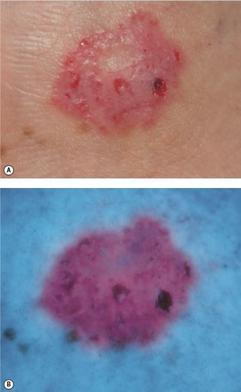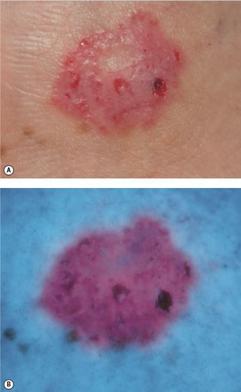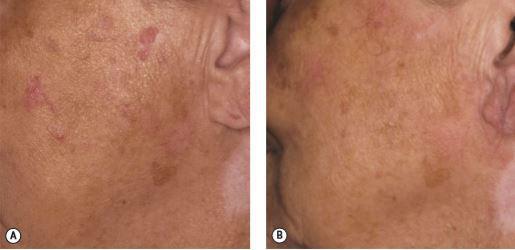Red Light- What is it?

- posted: Feb. 08, 2019
What is Photo-dynamic Therapy?
Photo-dynamic Therapy or PDT is a process by which a chemical is put on the skin. Certain types of skin cells take up the chemical and change it into a substance that is sensitive to light. Light is then shined on the skin, and the cells that took up the chemical die. PDT allows selective destruction of cells in the skin.
How does Photo-dynamic Therapy work?
Step 1: ALA (aminolevulinic acid) is applied to the skin. Pre-cancerous, cancerous, and oil gland cells take up the ALA and change it into porphyrins, most notably protoporphyrin IX (PpIX).
Step 2: The porphyrins are activated by red light. The activated porphyrins give off fluorescent light and create reactive oxygen species that kill the cell.
Step 3: After 48hours al off the porphyrins are used up.

What can PDT be used to treat?
PDT can treat actinic keratoses (AK), squamous cell carcinoma (SCC) in situ, and basal cell carcinoma (BCC). PDT can also help acne because it kills oil glands.
Will PDT make my skin look better?
Yes, if you have pre-cancerous cells, PDT will improve the texture and color of your skin by killing these cells. Keep in mind that PDT is not intended to be a ‘cosmetic procedure,’ however your skin may look better after treatment.

Is PDT covered by Health Insurance?
If your provider thinks that PDT is necessary for the health of your skin, your health insurance will likely cover the cost of the procedure.
How long does PDT take?
The procedure takes roughly 3 ½ hours. Typically, the incubation time lasts 2 ½ hours to 3 hours. The illumination process with the red light takes 10 minutes. Your skin will be sensitive to light for 48hours after the treatment. Your skin will be red and exfoliating for 1 week.
Author

Dr. Alexis Dougherty, MD Board Certified Dermatologist Mother Wife Beach volleyball player Runner From Texas Owner & Director of Kind Dermatology & Medical Spa

- posted: Feb. 08, 2019
What is Photo-dynamic Therapy?
Photo-dynamic Therapy or PDT is a process by which a chemical is put on the skin. Certain types of skin cells take up the chemical and change it into a substance that is sensitive to light. Light is then shined on the skin, and the cells that took up the chemical die. PDT allows selective destruction of cells in the skin.
How does Photo-dynamic Therapy work?
Step 1: ALA (aminolevulinic acid) is applied to the skin. Pre-cancerous, cancerous, and oil gland cells take up the ALA and change it into porphyrins, most notably protoporphyrin IX (PpIX).
Step 2: The porphyrins are activated by red light. The activated porphyrins give off fluorescent light and create reactive oxygen species that kill the cell.
Step 3: After 48hours al off the porphyrins are used up.

What can PDT be used to treat?
PDT can treat actinic keratoses (AK), squamous cell carcinoma (SCC) in situ, and basal cell carcinoma (BCC). PDT can also help acne because it kills oil glands.
Will PDT make my skin look better?
Yes, if you have pre-cancerous cells, PDT will improve the texture and color of your skin by killing these cells. Keep in mind that PDT is not intended to be a ‘cosmetic procedure,’ however your skin may look better after treatment.

Is PDT covered by Health Insurance?
If your provider thinks that PDT is necessary for the health of your skin, your health insurance will likely cover the cost of the procedure.
How long does PDT take?
The procedure takes roughly 3 ½ hours. Typically, the incubation time lasts 2 ½ hours to 3 hours. The illumination process with the red light takes 10 minutes. Your skin will be sensitive to light for 48hours after the treatment. Your skin will be red and exfoliating for 1 week.
Author

Dr. Alexis Dougherty, MD Board Certified Dermatologist Mother Wife Beach volleyball player Runner From Texas Owner & Director of Kind Dermatology & Medical Spa
Monday
8:30 am - 5:00 PM
Tuesday
8:30 am - 5:00 PM
Wednesday
8:30 am - 5:00 PM
Thursday
8:30 am - 5:00 PM
Friday
8:30 am - 5:00 PM
Saturday
Closed
Sunday
Closed
Visit our Office
601 East Arrellaga St Suite 101
Santa Barbara, CA 93103
